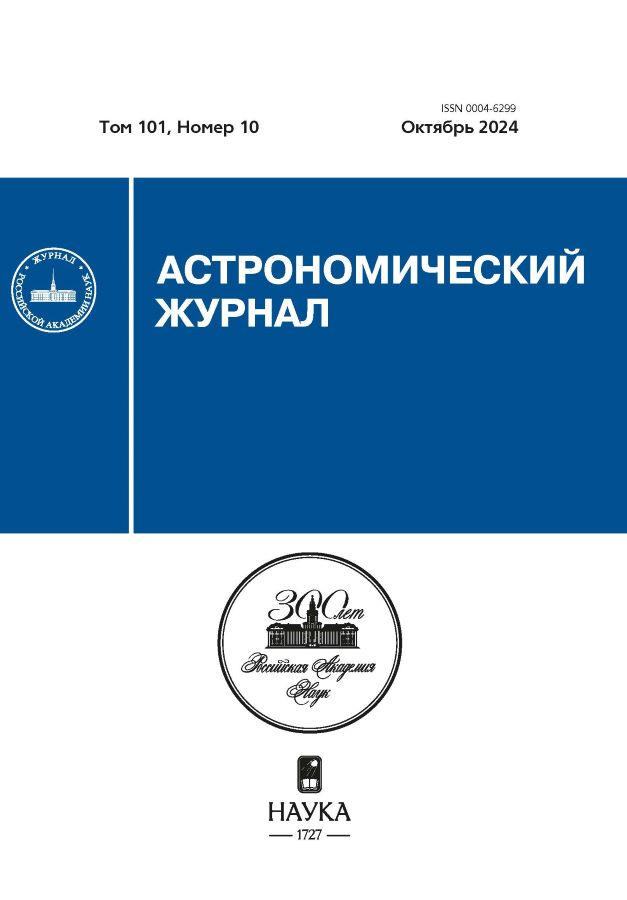Новый взгляд на структуру ближайшего околозвездного окружения звезды типа WTTS V718 Per
- Авторы: Гринин В.П.1,2, Сафонов Б.С.3, Ефимова Н.В.1, Барсунова О.Ю.1, Страхов И.А.3, Борман Г.А.4, Шугаров С.Ю.3,5
-
Учреждения:
- Главная (Пулковская) астрономическая обсерватория Российской академии наук
- Санкт-Петербургский государственный университет
- Государственный астрономический институт им. П. К. Штернберга, Московский государственный университет им. М. В. Ломоносова
- Крымская астрофизическая обсерватория Российской академии наук
- Астрономический институт Словацкой академии наук
- Выпуск: Том 101, № 10 (2024)
- Страницы: 903-911
- Раздел: СТАТЬИ
- URL: https://jdigitaldiagnostics.com/0004-6299/article/view/647663
- DOI: https://doi.org/10.31857/S0004629924100032
- EDN: https://elibrary.ru/JLWCQA
- ID: 647663
Цитировать
Полный текст
Аннотация
В статье анализируются особенности фотометрической и спектральной переменности молодой звезды V718 Per из скопления IC 348 с точки зрения ее возможной двойственности. Наиболее реалистичной выглядит модель, в которой главный компонент системы V718 Per A — звезда с эффективной температурой 5200 K — периодически экранируется двумя протяженными пылевыми структурами, состоящими из крупных частиц и движущимися вокруг звезды в резонансе с двумя планетами. Периоды их орбитального движения равны 4.7 года и 213 дням. Их отношение с высокой точностью равно 1:8, а отношение больших полуосей — 1:4. Массы планет не превышают 6 МJup. В моменты полных затмений V718 Per A в излучении системы доминирует более холодный компонент с эффективной температурой 4150 ± 100 K, что объясняет наблюдаемое в минимумах блеска покраснение звезды, а также изменения в ее спектре при переходе от яркого состояния к слабому. Спекл-интерферометрические наблюдения, выполненные на 2.5-м телескопе КГО ГАИШ МГУ, позволили оценить верхний предел на угловое расстояние между компонентами системы: ≤0.1′′, что эквивалентно проекционному расстоянию ≤30 а.е. Уникальная особенность этой системы состоит в том, что плоскости планетных орбит практически совпадают с лучом зрения. Такая ориентация системы наиболее благоприятна для измерений колебаний лучевой скорости звезды, вызванных орбитальным движением планет, а также для наблюдений транзитов планет по диску главного компонента системы.
Полный текст
Об авторах
В. П. Гринин
Главная (Пулковская) астрономическая обсерватория Российской академии наук; Санкт-Петербургский государственный университет
Автор, ответственный за переписку.
Email: vgcrao@mail.ru
Астрономический институт им. В. В. Соболева
Россия, Санкт-Петербург; Санкт-ПетербургБ. С. Сафонов
Государственный астрономический институт им. П. К. Штернберга, Московский государственный университет им. М. В. Ломоносова
Email: vgcrao@mail.ru
Россия, Москва
Н. В. Ефимова
Главная (Пулковская) астрономическая обсерватория Российской академии наук
Email: vgcrao@mail.ru
Россия, Санкт-Петербург
О. Ю. Барсунова
Главная (Пулковская) астрономическая обсерватория Российской академии наук
Email: vgcrao@mail.ru
Россия, Санкт-Петербург
И. А. Страхов
Государственный астрономический институт им. П. К. Штернберга, Московский государственный университет им. М. В. Ломоносова
Email: vgcrao@mail.ru
Россия, Москва
Г. А. Борман
Крымская астрофизическая обсерватория Российской академии наук
Email: vgcrao@mail.ru
Россия, п. Научный
С. Ю. Шугаров
Государственный астрономический институт им. П. К. Штернберга, Московский государственный университет им. М. В. Ломоносова; Астрономический институт Словацкой академии наук
Email: vgcrao@mail.ru
Россия, Москва; Татранска Ломница, Словакия
Список литературы
- R.E. Cohen, W. Herbst, and E.C. Williams, Astrophys. J. 596(2), L243 (2003).
- S. Nordhagen, W. Herbst, E.C. Williams, and E. Semkov, Astrophys. J. 646(2), L151 (2006).
- V.P. Grinin, O.Yu. Barsunova, S.G. Sergeev, N.Ya. Sotnikova, and T.V. Demidova, Astron. Letters 32(12), 827 (2006).
- V.P. Grinin, A.A. Arkharov, O.Yu. Barsunova, and S.G. Sergeev, Astron. Letters 35(12), 828 (2009).
- V. Grinin, H.C. Stempels, G.F. Gahm, S. Sergeev, A. Arkharov, O. Barsunova and L. Tambovtseva, Astron. and Astrophys. 489(3), 1233 (2008).
- K.E. Kearns and W. Herbst, Astron. J. 116(1), 261 (1998).
- C.M. Hamilton, W. Herbst, C. Shih, and A.J. Ferro, Astrophys. J. 554(2), L201 (2001).
- J.N. Winn, M.J. Holman, J.A. Johnson, K.Z. Stanek, and P.M. Garnavich, Astrophys. J. 603(1), L45 (2004).
- I.A. Strakhov, B.S. Safonov, and D.V. Cheryasov, Astrophys. Bull. 78(2), 234 (2023).
- A. Dodin, K. Grankin, S. Lamzin, A. Nadjip, et al., Monthly Not. Roy. Astron. Soc. 482, 5524 (2019).
- D.V. Bisikalo, A.V. Dodin, P.V. Kaigorodov, S.A. Lamzin, E.V. Malogolovets, and A.M. Fateeva, Astron. Rep. 56(9), 686 (2012).
- R.J. White and A.M. Ghez, Astrophys. J. 556(1), 265 (2001).
- A.A. Henden, S. Levine, D. Terrell, and D.L. Welch, AAS Meeting Abstracts 225, id. 336 (2015).
- C.J. Lada, A.A. Muench, K.L. Luhman, L. Allen, et al., Astron. J. 131(3), 1574 (2006).
- T. Currie and S.J. Kenyon, Astron. J. 138(3), 703 (2009).
- H.Y.A. Meng, G.H. Rieke, K.Y.L. Su, and A. Gáspár, Astrophys. J. 836(1), id. 34 (2017).
- E.L. Wright, P.R.M. Eisenhardt, A.K. Mainzer, M.E. Ressler, et al., Astron. J. 140(6), 1868 (2010).
- L.M. Ozernoy, N.N. Gorkavyi, J.C. Mather, and T.A. Taidakova, Astrophys. J. 537(2), L147 (2000).
- T.D. Pearce, H. Beust, V. Faramaz, M Booth, A.V. Krivov, T. Löhne, and P. Poblete, Monthly Not. Roy. Astron. Soc. 503(4), 4767 (2021).
- R. Luger, M. Sestovic, E. Kruse, S.L. Grimm, et al., Nature Astron. 1, id. 0129 (2017).
- C.J. Shallue and A. Vanderburg, Astron. J. 155(2), id. 94 (2018).
- T.J. David, E.A. Petigura, R. Luger, D. Foreman-Mackey, J.H. Livingston, E.E. Mamajek , and L.A. Hillenbrand, Astrophys. J. Letters, 885(1), id. L12 (2019).
Дополнительные файлы
















